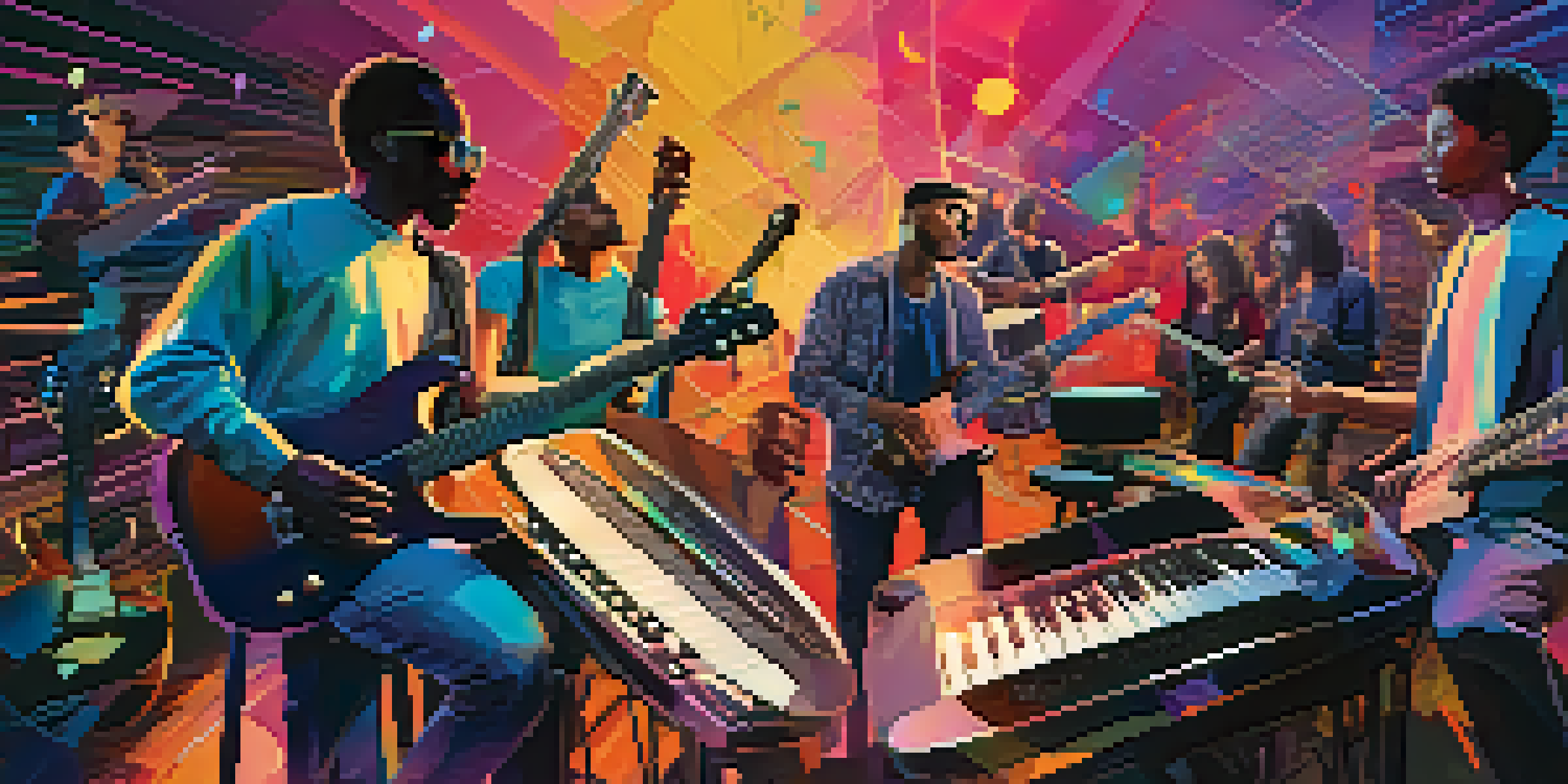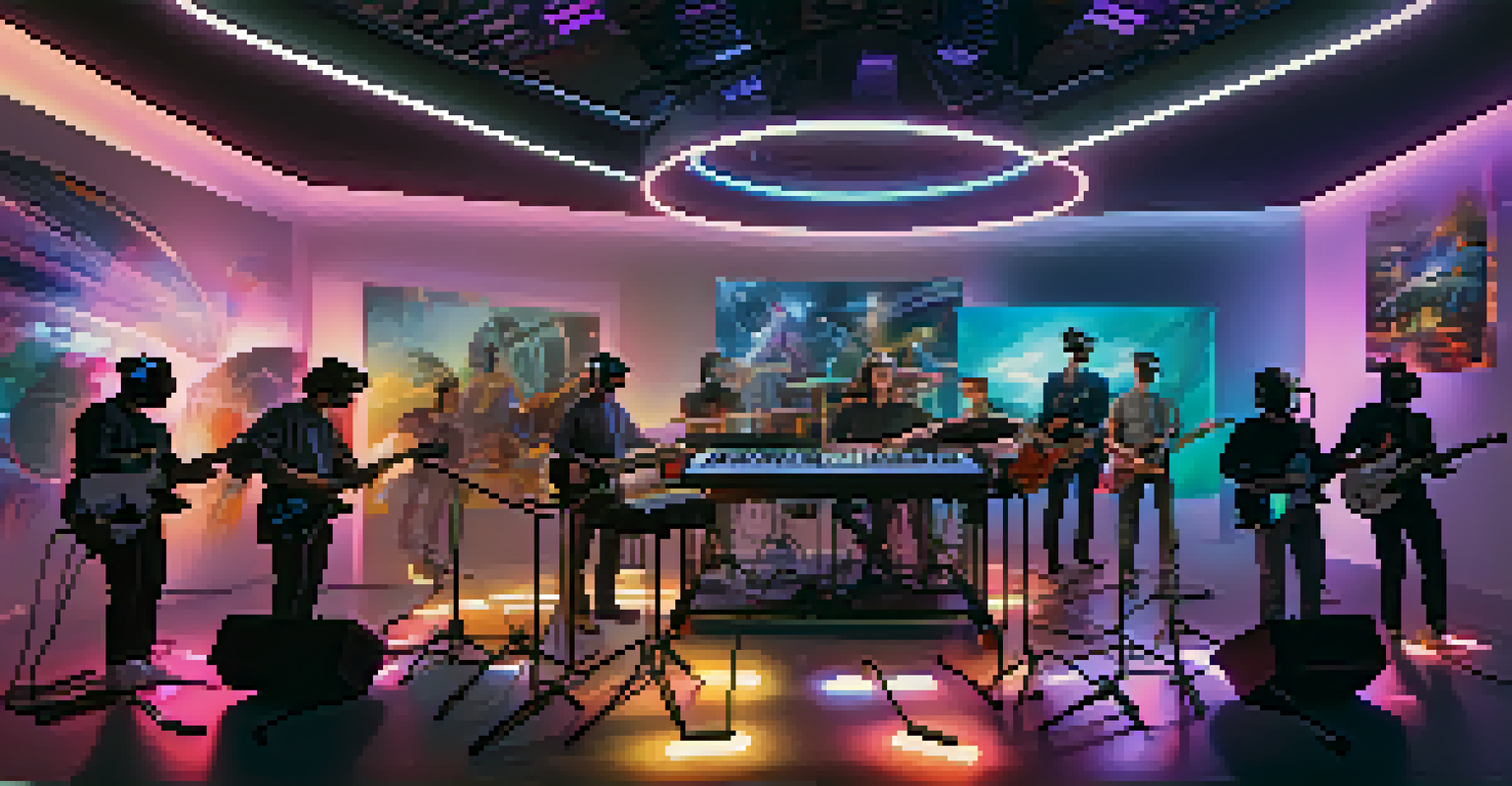The Role of Technology in Remote Guitar Collaborations

The Rise of Remote Collaboration in Music
In recent years, remote collaboration in music has gained significant traction. Musicians can now connect from anywhere in the world, breaking geographical barriers that once limited partnerships. This shift has not only expanded creative possibilities but also fostered diverse musical influences, enriching the collaborative process.
Music is the shorthand of emotion.
With the rise of platforms like Zoom and Skype, musicians can easily share ideas and feedback in real-time. This immediacy enhances the creative process, allowing artists to brainstorm and refine their work together, despite being miles apart. It's a game changer, particularly for guitarists who thrive on collaboration.
Moreover, the pandemic accelerated this trend, as many artists sought to connect while physically distanced. The result? A flourishing online community where creativity knows no bounds, leading to innovative projects that might never have materialized otherwise.
Essential Tools for Remote Guitar Collaboration
To facilitate effective remote collaborations, certain tools have become essential. Digital audio workstations (DAWs) like Ableton Live or GarageBand allow musicians to record and edit their tracks seamlessly. These platforms enable guitarists to layer their recordings, experiment with effects, and create polished pieces without needing to be in the same room.

Additionally, cloud storage solutions like Google Drive or Dropbox are invaluable for sharing files quickly and efficiently. Musicians can upload their guitar tracks and access each other’s work without fuss, streamlining the entire creative process. This ease of access encourages experimentation, as artists feel more inclined to share their raw ideas.
Remote Collaboration Expands Horizons
Musicians can now collaborate from anywhere, breaking geographical barriers and enriching the creative process.
Finally, communication tools such as Discord offer more than just voice calls; they create a virtual space for brainstorming and collaboration. Musicians can chat, share screens, and collaborate in real-time, making the experience feel more personal and interactive, despite the physical distance.
The Creative Process: Jamming from Afar
Jamming remotely can feel different than in-person sessions, but technology bridges that gap effectively. Many musicians use online platforms designed for real-time jamming, enabling them to play together as if they were in the same room. This experience can be exhilarating, allowing for spontaneous creativity and the thrill of improvisation.
The beautiful thing about learning is that no one can take it away from you.
However, these sessions are not without challenges. Latency, or the delay in sound transmission, can disrupt the flow of a jam. Musicians often have to adjust their timing or use specific software designed to minimize this lag, which can be a learning curve but ultimately leads to innovative solutions.
Despite these hurdles, many guitarists find that remote jamming enhances their adaptability and creativity. The need to communicate clearly and experiment with timing can lead to unexpected musical discoveries, pushing the boundaries of their artistic expression.
Leveraging Social Media for Collaboration
Social media platforms have revolutionized how musicians connect and collaborate. Guitarists can showcase their work on Instagram or TikTok, attracting potential collaborators from around the globe. This exposure not only widens their network but also inspires creative partnerships that might not have happened otherwise.
Moreover, many artists participate in online challenges or collaborations initiated by their peers. These challenges often encourage musicians to create and share their interpretations of a particular piece, fostering a sense of community and friendly competition. It's a fun way to engage with others while honing their craft.
Essential Tools Enhance Creativity
Digital audio workstations and cloud storage streamline collaboration, making it easier for musicians to share and refine their work.
Additionally, live streaming platforms allow musicians to perform together in real-time, reaching audiences worldwide. This interactive experience can lead to spontaneous collaborations, as viewers often suggest ideas or changes during the performance, creating a dynamic and engaging creative environment.
Challenges of Remote Guitar Collaborations
While technology offers incredible opportunities for remote collaboration, it also presents unique challenges. One of the primary hurdles is the potential for technical issues, such as poor internet connections or software glitches. These interruptions can disrupt the creative flow and lead to frustration, making it essential for musicians to be patient and adaptable.
Another challenge is maintaining the same level of connection that in-person collaborations often provide. Body language and immediate feedback can get lost in a virtual setting, sometimes hindering the creative process. Musicians need to develop other means of communication to ensure everyone feels included and valued during sessions.
Lastly, time zone differences can complicate scheduling collaborative sessions. Guitarists must be flexible and willing to find common ground to ensure that everyone can contribute their ideas and talents effectively, which can sometimes mean adjusting personal schedules for the sake of collaboration.
Innovative Software for Guitarists
As remote collaboration becomes more common, innovative software tailored for guitarists is emerging. Tools like JamKazam and Soundtrap allow musicians to jam and record together in real-time, regardless of their location. These platforms are specifically designed to handle the intricacies of music collaboration, making the experience smoother and more intuitive.
Additionally, virtual amplifiers and effect processors enable guitarists to experiment with various sounds and styles without needing physical gear. This accessibility encourages creativity and allows artists to explore new sounds that might inspire their collaborations.
Future of Collaboration Looks Bright
Advancements in technology will lead to more immersive and innovative remote collaborations, fostering a diverse musical landscape.
Ultimately, technology continues to evolve, providing guitarists with more resources than ever before. As new software emerges, musicians can expect to see even more innovative ways to collaborate remotely, enhancing their creative journeys.
The Future of Remote Guitar Collaborations
Looking ahead, the future of remote guitar collaborations seems bright. As technology advances, we can expect even more seamless integrations of virtual reality and augmented reality into the music-making process. Imagine jamming with artists in a virtual space that mimics a real studio environment, making remote collaborations feel even more tangible.
Moreover, as musicians become increasingly comfortable with remote tools, we may see a rise in cross-genre and cross-cultural collaborations. This blending of styles and influences can lead to groundbreaking music that reflects a more global perspective, enriching the musical landscape for everyone.

Ultimately, technology is transforming the way guitarists collaborate, creating endless possibilities for creativity and connection. Embracing these changes will not only enhance individual projects but also foster a vibrant community of musicians who can share their passion for music, regardless of where they are in the world.